Mountains and Rivers Sesshin
Point Reyes, August, 2002
The Patriarch Ta-yang Shan-k'ai addressed the assembly: "The
blue mountains are constantly walking. The stone woman gives birth to a
child in the night." The mountains lack none of their proper virtues; and
therefore, they are constantly at rest and constantly walking. We must study
this virtue of walking in detail. The walk of the mountains is like that of
men; so we must not doubt that the mountains walk simply because they may
not appear to stride like humans. This teaching of the Patriarch in fact
points out such walking; it has attained the fundamental, and we should give
his teaching on "constant walking" a thorough study.*
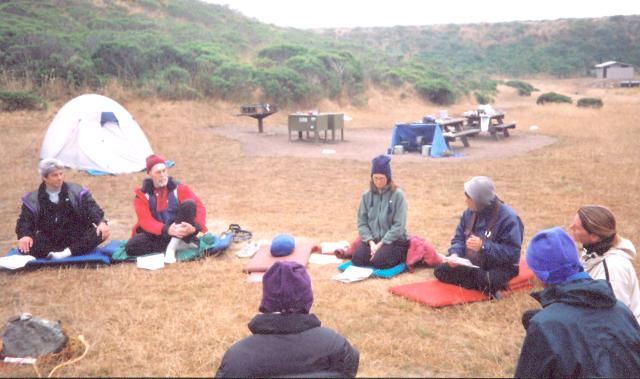 It is amazing to me, sometimes, how
much baggage I find myself hauling up a mountain. I try to keep it simple, try
to pare it all down to the minimum. But still, it seems, things keep creeping
back in. And not just the physical stuff. There's all that mental baggage, too.
It was not until after I had returned home from this trip that I began to
realize just how much of that there was. Especially the grieving, which I had
thought had run its course. But no, it was still there and would not be
ignored.
It is amazing to me, sometimes, how
much baggage I find myself hauling up a mountain. I try to keep it simple, try
to pare it all down to the minimum. But still, it seems, things keep creeping
back in. And not just the physical stuff. There's all that mental baggage, too.
It was not until after I had returned home from this trip that I began to
realize just how much of that there was. Especially the grieving, which I had
thought had run its course. But no, it was still there and would not be
ignored.
Once, not long after the memorial service for Rosemary, I found myself wondering
"if nothing abides, where does this sorrow come from, and who is it that
suffers?" It seems there is yet a mountain of grief to climb, along with this
pile of rock, dirt, and trees.
If you have doubts about the walking of mountains it means
you do not yet know the walking of your own self. It is not that your self
does not walk, but that you do not yet know, have not made clear its
walking. And those who would know their own walking must also know the
walking of the blue mountains.
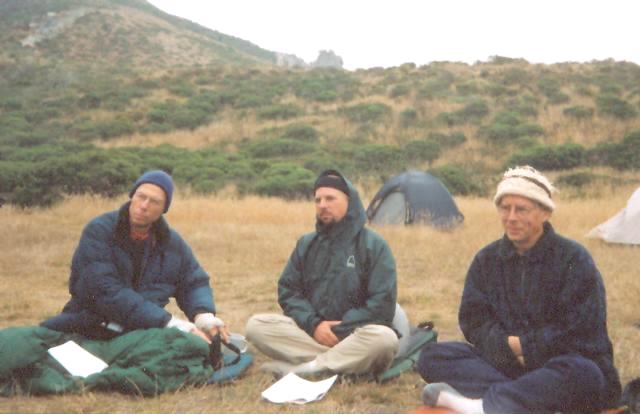 This landscape, with such obvious
signs of Earth's movement, is not such a bad place to ponder the mountains'
walking. We are separated from the mainland by the San Andreas fault, with
Bolinas Bay and other features attesting to the mountains' strides. These
thoughts and Dogen's words accompany me on the trail.
This landscape, with such obvious
signs of Earth's movement, is not such a bad place to ponder the mountains'
walking. We are separated from the mainland by the San Andreas fault, with
Bolinas Bay and other features attesting to the mountains' strides. These
thoughts and Dogen's words accompany me on the trail.
When we hear a voice, it is vibrations of the air that carry the sound to
us, and it is the changing pitch of those vibrations that carry the meaning.
Mountains live in geological time scales which are so vast that we can not
really comprehend them. Their speech occupies a similar time scale, and it
must surely take a hundred years to utter just one syllable of mountain speech.
The pitch is so low we can not even detect it. But sometimes, of course, the
mountains' striding snaps into our own time scale. The earth may move several
feet in the space of a heartbeat with consequences disastrous for our creations.
That, too, is speech and movement that we cannot ignore.
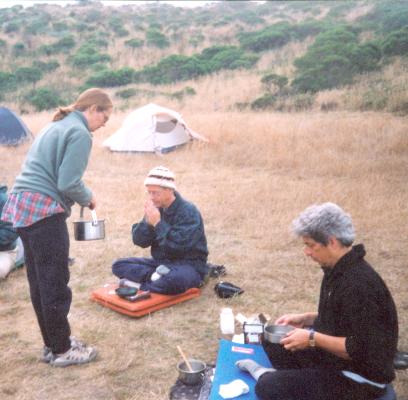 Dogen lived in a landscape similarly
transformed by massive earthquakes. Is it too much to suppose that he had
similar thoughts? His subtle words, of course, go far beyond such thoughts, but
we have to start from somewhere when entering the mountains. Sometimes I resent all these thought that crowd into my mind, but I begin to realize that, like the pain in my legs while sitting, I need to accept them as my friends. Like the pain, they remind me that I am alive and that I have much for which to be grateful. So I welcome them as phenomena, like the trees and shrubs along the path.
Dogen lived in a landscape similarly
transformed by massive earthquakes. Is it too much to suppose that he had
similar thoughts? His subtle words, of course, go far beyond such thoughts, but
we have to start from somewhere when entering the mountains. Sometimes I resent all these thought that crowd into my mind, but I begin to realize that, like the pain in my legs while sitting, I need to accept them as my friends. Like the pain, they remind me that I am alive and that I have much for which to be grateful. So I welcome them as phenomena, like the trees and shrubs along the path.
The gentle road we follow is over-arched by ancient trees, and it is, at
first, not obvious that we are even approaching a mountain. Walking in
silence, right now there is only the sound of our own feet crunching the
gravel on the path, the water flowing, and birds singing. But soon we take a
trail that branches to the right and crosses the creek. It climbs steeply
and before long we find ourselves crossing the shoulder of Mt. Wittenberg.
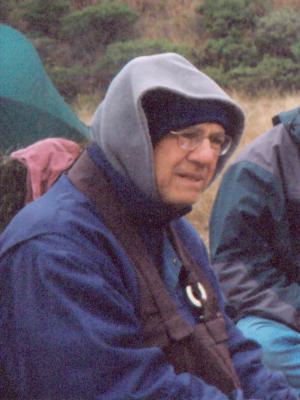 Driving through the night before, I had not really
expected to be able to arrive in time to join the group for the beginning of the
trek. But as I came closer to the meeting place, and it appeared that I would
not be too late, I remembered twenty years before. Then when I was preparing to
move back to Oregon from my brief stay in Berkeley, we had had a farewell dinner
hosted by the woman whose house I had shared. As the dinner drew to a close, I
began to get anxious about getting to the next event where Sojun's attendance
was expected. I don't recall his words at the time, but the lesson was clear: do
this completely before moving on, the next event will have its own time. And
in fact, I arrived at the meeting place before most of the others, whose
breakfast plans had changed at the last minute.
Driving through the night before, I had not really
expected to be able to arrive in time to join the group for the beginning of the
trek. But as I came closer to the meeting place, and it appeared that I would
not be too late, I remembered twenty years before. Then when I was preparing to
move back to Oregon from my brief stay in Berkeley, we had had a farewell dinner
hosted by the woman whose house I had shared. As the dinner drew to a close, I
began to get anxious about getting to the next event where Sojun's attendance
was expected. I don't recall his words at the time, but the lesson was clear: do
this completely before moving on, the next event will have its own time. And
in fact, I arrived at the meeting place before most of the others, whose
breakfast plans had changed at the last minute.
After a brief rest, we continue on over the shoulder of Mt. Wittenberg
towards the coast, stopping for lunch on a high promontory overlooking the
ocean and our camp. By now the clouds are pressing in on us. After the
previous night's long drive through the hot valley, this is a welcome sight
for me. On the freeway I had descended from the Siskiyou Mountains after
midnight into Yreka, finding the whole valley choked with smoke from forest
fires to the west. But now in the blowing mist above the ocean, that seems very
far away, indeed. In the distance, I can just make out a white deer moving
through the brush.
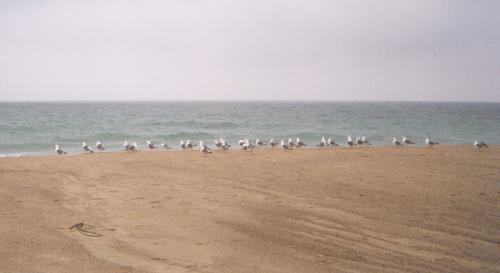 Thinking of "mountains walking," I recall
Dogen's Genjokoan, in which he refers to birds flying in the air and fish
swimming in the water. Is this walking of mountains like the flight of birds? If
so, in what medium is it that mountains walk? While there is a superficial
similarity here, it seems more like the story he brings up later in
Genjokoan: a monk asks metaphorically about the necessity of practice,
"The nature of wind is permanently abiding and there is no place it does not
reach. Why, master, do you still use a fan?"** Is this walking of mountains, are
these mountains themselves then, like the Dharma wind that reaches
everywhere?
Thinking of "mountains walking," I recall
Dogen's Genjokoan, in which he refers to birds flying in the air and fish
swimming in the water. Is this walking of mountains like the flight of birds? If
so, in what medium is it that mountains walk? While there is a superficial
similarity here, it seems more like the story he brings up later in
Genjokoan: a monk asks metaphorically about the necessity of practice,
"The nature of wind is permanently abiding and there is no place it does not
reach. Why, master, do you still use a fan?"** Is this walking of mountains, are
these mountains themselves then, like the Dharma wind that reaches
everywhere?
The mountains have always been the timeless dwelling place of
the great sages; both wise men and sages have made the mountains their
abode, their own body and mind. And through these wise men and sages the
mountains have been actualized. However many great sages and wise men we
suppose have assembled in the mountains, in fact ever since they entered the
mountains there is no one who has met a single one of them. For this is
nothing but the expression of the life of the mountains: not a single trace
of their having entered the mountains remains.
At the campsite, we pitch our tents, and while others explore the area, I
climb into my tent and sleep until zazen, service and dinner beginning at
5:00 PM.
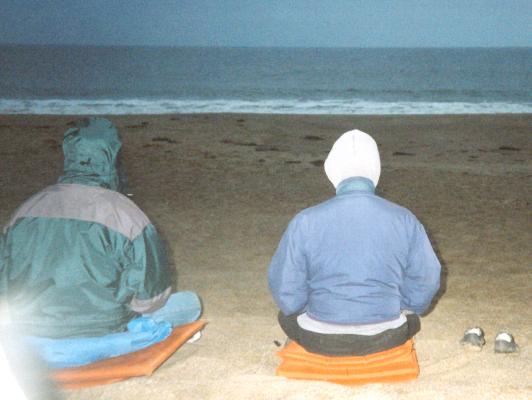 I had been apprehensive about sitting outside,
and using a sleeping bag and pad for zafu and zabuton, but those concerns
evaporate as quickly as my pad becomes soaked with dew. And later, sitting on
the beach as the light grows dim, I feel remarkably exhilarated, even shedding
the coat that I had worn, expecting a bitterly cold wind to chill me to the
core. Instead, a warm breeze provides a soothing embrace. I am overwhelmed with
gratitude for this practice, these people, this opportunity, my eyes filling
with tears. Sorrow, grief, remorse, gratitude, and joy all seem so intense now.
After all these years delusion and attachment seem greater than ever. There is
so little understanding, the path seems ever more obscure. I'm not even sure if
I am the one attached, or is it the emotion that attaches to me? And I wonder if
I will ever get beyond the First Noble Truth. Kate Wolf's wise words echo in my mind and offer comfort: "love has made a circle that holds us all inside, where strangers are as family and loneliness can't hide ..."*** All these emotions crowd in and sometimes I can barely distinguish one from another. Love and hate -- are they really much different? Or are they like the other thoughts, just more mental phenomena to greet and accept?
I had been apprehensive about sitting outside,
and using a sleeping bag and pad for zafu and zabuton, but those concerns
evaporate as quickly as my pad becomes soaked with dew. And later, sitting on
the beach as the light grows dim, I feel remarkably exhilarated, even shedding
the coat that I had worn, expecting a bitterly cold wind to chill me to the
core. Instead, a warm breeze provides a soothing embrace. I am overwhelmed with
gratitude for this practice, these people, this opportunity, my eyes filling
with tears. Sorrow, grief, remorse, gratitude, and joy all seem so intense now.
After all these years delusion and attachment seem greater than ever. There is
so little understanding, the path seems ever more obscure. I'm not even sure if
I am the one attached, or is it the emotion that attaches to me? And I wonder if
I will ever get beyond the First Noble Truth. Kate Wolf's wise words echo in my mind and offer comfort: "love has made a circle that holds us all inside, where strangers are as family and loneliness can't hide ..."*** All these emotions crowd in and sometimes I can barely distinguish one from another. Love and hate -- are they really much different? Or are they like the other thoughts, just more mental phenomena to greet and accept?
Saturday, after the morning sitting and breakfast, another white deer bounds
over the ridge behind our camp. During the lecture period, we read Dogen's sutra
aloud, each person reading a paragraph in turn. Afterwards, Sojun responds to
questions. Someone asks how we are to understand "ownership" when Dogen says
"Although we say that mountains belong to the country, actually they belong to
those who love them. ... And when sages and wise men live in the mountains,
because the mountains belong to them, trees and rocks flourish and abound, and
the birds and beasts have a supernatural excellence." In this context, ownership
is to be understood very broadly, he says. Picking a blade of dry grass to
illustrate his point, he says that while he may be holding the grass, he does
not really "own" it in an exclusionary sense. He holds this dead leaf, but all I
can see is Sakyamuni holding up a flower, and once again I dissolve in
tears.
Later we discuss what to do for the next day's lecture. Sojun suggests
three options: everyone can bring a poem, or we could create a poem, each
person adding a line as we go around the circle. There is so much interest
in these that we never hear the third option.
Walking on the beach later in the day I find myself recalling, as so often
happens, the lines from The Walrus and the Carpenter,
They wept like anything to see such quantities of sand:
"If
this were only cleared away," They said, "it would be grand!"
"If seven
maids with seven mops swept for half a year,
Do you suppose," the Walrus
said, "That they could get it clear?"
"I doubt it," said the Carpenter, and
shed a bitter tear.
Thus, combined with all the suffering and the compassion which surrounds me
and seems so palpable, came my poem,
Bitter tears,
Tears of joy
This ocean
Surrounds
And comforts
us.
Sunday morning, as I cleaned out the cooking pots from breakfast, I put
the leftovers in plastic bags and carried them to the garbage bins.
Unfortunately, it hadn't occurred to me that the cooked cereal was still quite
warm, and before I reached the bins, the bottom of the bag fell out, all of it
landing splat! in the middle of the path. Normally, that would have been a
stressful occurrence, but at the time, I just laughed out loud!
I couldn't recall a period of zazen as hard as the last one that morning had
been. But at the same time, I couldn't recall ever having had the same sense
of accepting things as they are. I could not have asked for more. And hiking
out that afternoon, I began to realize how much I had gained in many ways, not
the least of which was a greater confidence in understanding Dogen's writing
and a new perspective on the Cold Mountain poems. While I had treasured these
for many years, and understood the various levels of meaning in an academic
way, suddenly I could accept the meaning in a new way, as though I were
actually in the mountains.
Despite all of this, I was glad to return to Oregon. Driving north,
I stopped after midnight for a nap in a rest area just over the border. The
first person to whom I spoke the next morning was a gas station attendant in
Reedsport. At the end of our transaction he said "thank you" with such a sincere
tone of voice, and with a manner that seemed symbolic of the best reasons I
feel so much at home here, that I wanted to jump out and give him a hug! A
little farther along, I stopped to eat in Florence. Sitting at a table in a
small restaurant I found tears streaming down my face, just so happy to be here,
wherever that "here" may be. I don't understand this sense of place, and why I'm
so attached to it, and others don't seem to have any particular attachment at
all. Is it even really a form of attachment? I don't really understand just what
that "here" really means. I wonder, then, why did Dogen return to Japan
instead of staying in China?
The master replied "You only know that the nature of wind is
permanently abiding, but you do not yet know the true meaning of 'There is
no place it does not reach'."
* Quotations from the Carl Bielefeldt translation of Dogen Zenji's
Mountains and Rivers Sutra, fascicle 29 of the Shobogenzo. A more recent
version is available from the Soto Zen Text Project.
** From Paul Jaffe's translation of Hakuun Yasutani's commentary Flowers
Fall, Shambala, 1996.
*** Kate Wolf, "Give Yourself To Love," 1982 BMI
Photos by Ken Knabb.
 It is amazing to me, sometimes, how
much baggage I find myself hauling up a mountain. I try to keep it simple, try
to pare it all down to the minimum. But still, it seems, things keep creeping
back in. And not just the physical stuff. There's all that mental baggage, too.
It was not until after I had returned home from this trip that I began to
realize just how much of that there was. Especially the grieving, which I had
thought had run its course. But no, it was still there and would not be
ignored.
It is amazing to me, sometimes, how
much baggage I find myself hauling up a mountain. I try to keep it simple, try
to pare it all down to the minimum. But still, it seems, things keep creeping
back in. And not just the physical stuff. There's all that mental baggage, too.
It was not until after I had returned home from this trip that I began to
realize just how much of that there was. Especially the grieving, which I had
thought had run its course. But no, it was still there and would not be
ignored. This landscape, with such obvious
signs of Earth's movement, is not such a bad place to ponder the mountains'
walking. We are separated from the mainland by the San Andreas fault, with
Bolinas Bay and other features attesting to the mountains' strides. These
thoughts and Dogen's words accompany me on the trail.
This landscape, with such obvious
signs of Earth's movement, is not such a bad place to ponder the mountains'
walking. We are separated from the mainland by the San Andreas fault, with
Bolinas Bay and other features attesting to the mountains' strides. These
thoughts and Dogen's words accompany me on the trail. Dogen lived in a landscape similarly
transformed by massive earthquakes. Is it too much to suppose that he had
similar thoughts? His subtle words, of course, go far beyond such thoughts, but
we have to start from somewhere when entering the mountains. Sometimes I resent all these thought that crowd into my mind, but I begin to realize that, like the pain in my legs while sitting, I need to accept them as my friends. Like the pain, they remind me that I am alive and that I have much for which to be grateful. So I welcome them as phenomena, like the trees and shrubs along the path.
Dogen lived in a landscape similarly
transformed by massive earthquakes. Is it too much to suppose that he had
similar thoughts? His subtle words, of course, go far beyond such thoughts, but
we have to start from somewhere when entering the mountains. Sometimes I resent all these thought that crowd into my mind, but I begin to realize that, like the pain in my legs while sitting, I need to accept them as my friends. Like the pain, they remind me that I am alive and that I have much for which to be grateful. So I welcome them as phenomena, like the trees and shrubs along the path. Driving through the night before, I had not really
expected to be able to arrive in time to join the group for the beginning of the
trek. But as I came closer to the meeting place, and it appeared that I would
not be too late, I remembered twenty years before. Then when I was preparing to
move back to Oregon from my brief stay in Berkeley, we had had a farewell dinner
hosted by the woman whose house I had shared. As the dinner drew to a close, I
began to get anxious about getting to the next event where Sojun's attendance
was expected. I don't recall his words at the time, but the lesson was clear: do
this completely before moving on, the next event will have its own time. And
in fact, I arrived at the meeting place before most of the others, whose
breakfast plans had changed at the last minute.
Driving through the night before, I had not really
expected to be able to arrive in time to join the group for the beginning of the
trek. But as I came closer to the meeting place, and it appeared that I would
not be too late, I remembered twenty years before. Then when I was preparing to
move back to Oregon from my brief stay in Berkeley, we had had a farewell dinner
hosted by the woman whose house I had shared. As the dinner drew to a close, I
began to get anxious about getting to the next event where Sojun's attendance
was expected. I don't recall his words at the time, but the lesson was clear: do
this completely before moving on, the next event will have its own time. And
in fact, I arrived at the meeting place before most of the others, whose
breakfast plans had changed at the last minute. Thinking of "mountains walking," I recall
Dogen's Genjokoan, in which he refers to birds flying in the air and fish
swimming in the water. Is this walking of mountains like the flight of birds? If
so, in what medium is it that mountains walk? While there is a superficial
similarity here, it seems more like the story he brings up later in
Genjokoan: a monk asks metaphorically about the necessity of practice,
"The nature of wind is permanently abiding and there is no place it does not
reach. Why, master, do you still use a fan?"** Is this walking of mountains, are
these mountains themselves then, like the Dharma wind that reaches
everywhere?
Thinking of "mountains walking," I recall
Dogen's Genjokoan, in which he refers to birds flying in the air and fish
swimming in the water. Is this walking of mountains like the flight of birds? If
so, in what medium is it that mountains walk? While there is a superficial
similarity here, it seems more like the story he brings up later in
Genjokoan: a monk asks metaphorically about the necessity of practice,
"The nature of wind is permanently abiding and there is no place it does not
reach. Why, master, do you still use a fan?"** Is this walking of mountains, are
these mountains themselves then, like the Dharma wind that reaches
everywhere? I had been apprehensive about sitting outside,
and using a sleeping bag and pad for zafu and zabuton, but those concerns
evaporate as quickly as my pad becomes soaked with dew. And later, sitting on
the beach as the light grows dim, I feel remarkably exhilarated, even shedding
the coat that I had worn, expecting a bitterly cold wind to chill me to the
core. Instead, a warm breeze provides a soothing embrace. I am overwhelmed with
gratitude for this practice, these people, this opportunity, my eyes filling
with tears. Sorrow, grief, remorse, gratitude, and joy all seem so intense now.
After all these years delusion and attachment seem greater than ever. There is
so little understanding, the path seems ever more obscure. I'm not even sure if
I am the one attached, or is it the emotion that attaches to me? And I wonder if
I will ever get beyond the First Noble Truth. Kate Wolf's wise words echo in my mind and offer comfort: "love has made a circle that holds us all inside, where strangers are as family and loneliness can't hide ..."*** All these emotions crowd in and sometimes I can barely distinguish one from another. Love and hate -- are they really much different? Or are they like the other thoughts, just more mental phenomena to greet and accept?
I had been apprehensive about sitting outside,
and using a sleeping bag and pad for zafu and zabuton, but those concerns
evaporate as quickly as my pad becomes soaked with dew. And later, sitting on
the beach as the light grows dim, I feel remarkably exhilarated, even shedding
the coat that I had worn, expecting a bitterly cold wind to chill me to the
core. Instead, a warm breeze provides a soothing embrace. I am overwhelmed with
gratitude for this practice, these people, this opportunity, my eyes filling
with tears. Sorrow, grief, remorse, gratitude, and joy all seem so intense now.
After all these years delusion and attachment seem greater than ever. There is
so little understanding, the path seems ever more obscure. I'm not even sure if
I am the one attached, or is it the emotion that attaches to me? And I wonder if
I will ever get beyond the First Noble Truth. Kate Wolf's wise words echo in my mind and offer comfort: "love has made a circle that holds us all inside, where strangers are as family and loneliness can't hide ..."*** All these emotions crowd in and sometimes I can barely distinguish one from another. Love and hate -- are they really much different? Or are they like the other thoughts, just more mental phenomena to greet and accept?